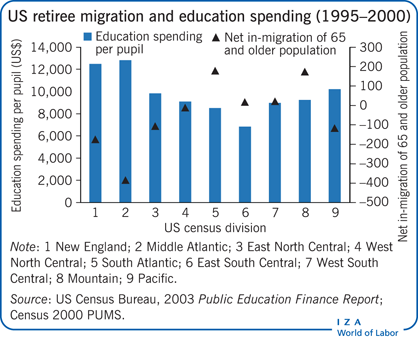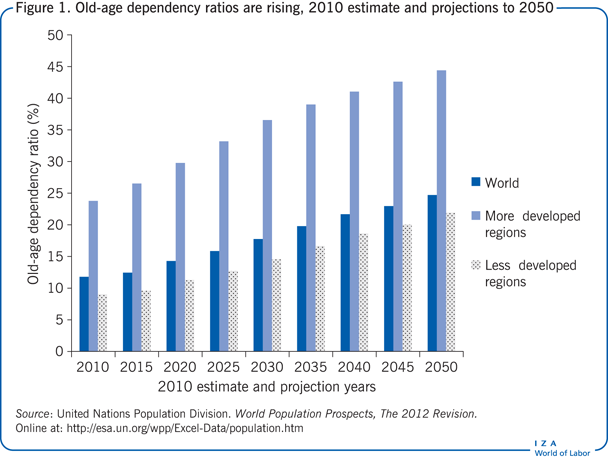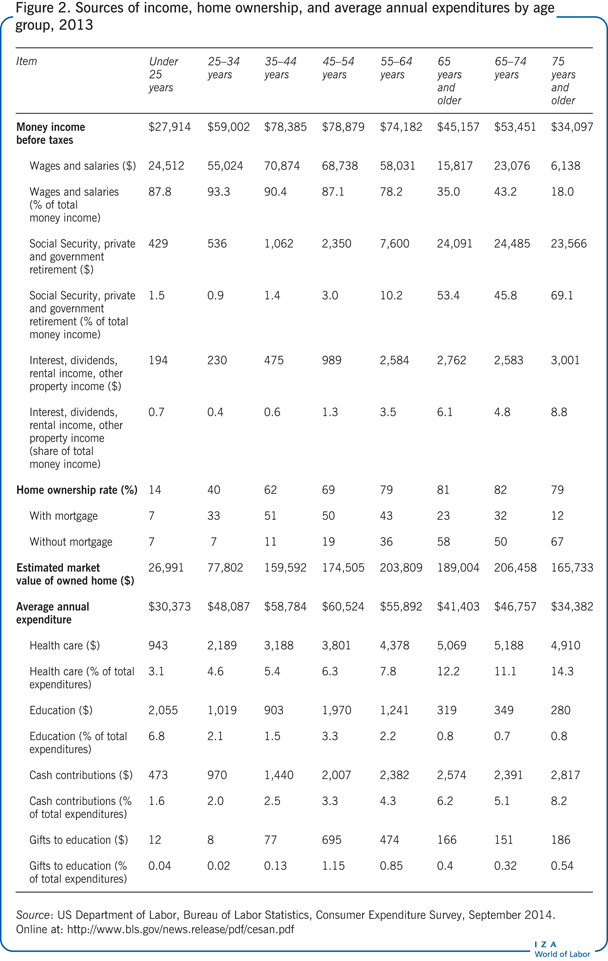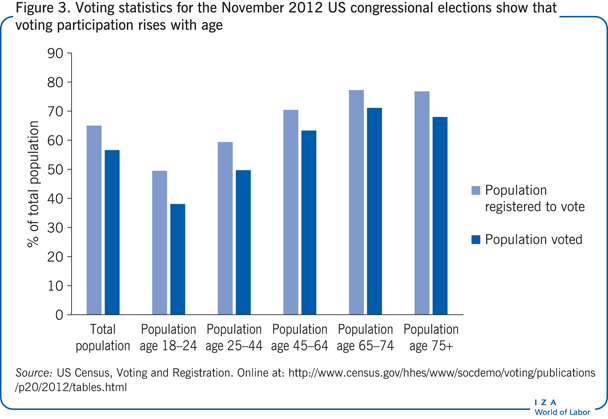Elevator pitch
With the aging of populations, particularly in more developed countries, retirees are becoming a politically influential group. Government budgets have been feeling the strain on social insurance, health care, and other programs that benefit the elderly. Yet spending on these programs has often come at the expense of other programs such as education, which benefit primarily the younger population. Attracting retirees has been viewed as an important avenue of economic development, with positive impacts on revenue and expenditure. However, it can also have a negative impact on education spending potentially resulting in intergenerational fiscal conflict.

Key findings
Pros
Retirees are relatively wealthy and can have a substantial economic and fiscal impact on local economies, relieving pressure on governments to finance programs and reducing intergenerational conflict over government spending priorities.
Retirees tend to locate in areas where education spending and taxes are already low, but they do not necessarily influence local policy making.
Some retirees are altruistic and contribute significantly to localities, particularly rural retirement destination communities, through volunteering and participating in education programs.
Cons
Retirees are active politically and influence fiscal policy making more directly at the state and local levels, which can result in policy decisions that lead to conflict with programs for the younger population.
Retirees, who see some indirect return to education at the local level, are less willing to support education at the state or province level, where they see less benefit.
Rising numbers of retirees boost social insurance and welfare expenditures, which take resources away from other government programs that benefit the young, such as education.
Author's main message
As the population ages and the share of retirees rises, the possibility of intergenerational conflict between youth and the elderly over government programs becomes more likely. One potential area of conflict is education spending. The evidence points to conflict more with the state-level data than with the local-level data, and finds conflict to be associated more strongly with retiree migrants and younger retirees. Some possible policy options are more central government involvement in education spending, and support for continuing education and other community programs to connect retirees to communities and the education system.
Motivation
Countries around the world, particularly in more developed regions, are going through a period of great demographic change referred to as population aging. Figure 1 shows this trend for both more developed regions and less developed regions using projections of the old-age dependency ratio. This measure—the ratio of older dependents to the working-age population—is a commonly used indicator of population aging. The old-age dependency ratio is almost three times higher for more developed regions than for less developed regions, but the ratio is projected to increase for both types of region, with the gap between the two narrowing over time.

With this aging trend, retirees have become an important group for economies and governments, particularly in the context of what is known as the “demographic deficit.” This term refers to an imbalance in the human population of a country, province, or other jurisdiction that arises mainly from differences in age, gender, or geographic concentration of the population. Demographic deficit has recently been associated with population aging; and migration as a response to or a contributing factor of demographic deficit has received particular attention. A demographic deficit does not always turn into an economic or fiscal deficit. That depends on a country’s institutions and policy responses. Thus, while retirees may pose fiscal challenges, they can also enhance economic development, particularly at the local level. The economic and fiscal impacts are especially important as relatively younger and healthy retirees move into an area, making retiree migration an important policy topic.
Discussion of pros and cons
Economic and fiscal impact of population aging and rising numbers of retirees
Since the impact of retirees on the economy is driven largely by population aging, it is important to start by discussing the economic and fiscal effects of aging. Population aging is expected to have a dampening effect on the economy through eventual declines in the labor force and in savings per capita. This economic impact would in turn be expected to lead to potentially significant negative fiscal impacts, particularly through increased spending on social insurance programs. With large increases in the old-age dependency ratio, as shown in Figure 1, governments will experience rising fiscal pressure to increase tax revenue from the working population and spend it on social insurance, health care, and other welfare programs that benefit the elderly at the expense of programs that benefit the young, such as education. Since education is a critical input to human capital accumulation, any negative impact on education spending can also have important negative consequences for economic growth.
At the same time, retirees can have important positive economic impacts at the subnational level, in states and local jurisdictions, especially as retirees migrate. Attracting younger and healthier retirees from the baby-boom generation (those born between 1946 and 1964) has become a local economic development priority for state and local governments in the US. One important reason for this focus is that retirees of the baby-boom generation are wealthier and healthier than retirees of previous generations, which makes them a potentially mobile group. Numerous studies have pointed to positive economic and fiscal impacts of this group, particularly in the short term. Thus, there has been fairly intense interstate competition in the US in attracting these retirees. Many state policy agendas have included inducing retiree migration as an economic development strategy. States have offered tax incentives to attract particularly wealthy retirees.
To understand the economic and fiscal impact of an aging population, it helps to know that retirees and younger population groups have different income and spending patterns. Data from the US Consumer Expenditure Survey show substantial differences between retirees and people in other age groups in sources of income, wealth, and spending (Figure 2). Retirees in the 65 years and older age groups are quite wealthy. While their income from wages and salaries and their money income are much lower, for obvious reasons, they have substantially higher social insurance and retirement income and capital income from interest, dividends, and rental and other property. They also have the highest home-ownership rate of any age group and are mostly without mortgages. Most retirees, particularly those in the 75 years and older age group, have already paid off their mortgages and fully own their home. The estimated market value of their homes is among the highest for all age groups.

The average annual expenditures of retirees are also lower than those of people in younger age groups, though retirees spend substantially more on health care and substantially less on education. And while retirees’ cash contributions to charity are fairly high, their gift spending on education is much lower than that of people in other age groups. Thus, while retirees’ income and wealth can potentially generate strong economic and fiscal impacts, there is no reason to expect that retirees will directly support education spending.
Retirees and intergenerational conflict in education spending in the United States
Retirees are a politically active and potentially mobile and influential demographic group in the US. Voting statistics from the 2012 congressional elections show that the political participation of the voting-age population rises with age (Figure 3). To understand the considerable differences in political participation between younger and older voters in the US, consider the voting statistics for the youngest age group, those 18–24 years old, and the 65–74 year old group, which consists of people referred to as the “young old.” While the youngest age group had the lowest percentage of registered voters (49.4%) and actual voters (38%), those in the 65–74 year old group had the highest percentage of registered voters (77.1%) and actual voters (71.1%). Thus, the voting percentage was 87% higher for the older group, and the gap between registered voters and voters was twice as large for the younger group (11.4%) as for the older group (6%).

Theoretical studies
A number of theoretical studies have explored what these differences in political participation could mean for fiscal policy, particularly for government spending on education [1], [2], [3]. These studies used an overlapping generations growth model, which brings young and old generations together in any given period in the same modeling framework, to examine the consequences of possible intergenerational conflict over fiscal policy. If political processes are such that it is easier to sustain policies that favor the elderly population, this could mean lower government spending on education if the elderly population does not see the benefits of such spending [1]. Similarly, the aging of the population can shift the identity of the median voter toward one with government spending preferences closer to those of the elderly voting group. Thus, the outcome of an election with respect to fiscal policy preferences, particularly at the state and local government levels, also moves closer to choices preferred by the elderly [3].
On the other hand, with longevity increasing (a contributor to population aging, as people live longer), people may see the benefit of increasing support for education when they are young so that they can enjoy a higher return to their savings for retirement. It is also the case that most social insurance spending related to retirees would be borne by the central government, so the burden on state and local governments would be limited. Also, retirees would not add to the cost of public education the way families with school-age children would [4]. Moreover, retirees might support education at the local level if they believe that higher education spending would improve the quality of education, which could be capitalized into housing prices. That would benefit the elderly population by keeping the value of their housing asset high.
While there are good theoretical arguments maintaining that education spending can be negatively affected by population aging and rising numbers of elderly retirees, there are counter-arguments showing how future retirees could benefit from greater support for education spending today. There are also arguments that show the potential benefits of having a larger retiree population at the state and local government levels. Thus, there is no consensus at a theoretical level on the question of intergenerational conflict.
Empirical studies
The link between retirees and government spending on education has also been examined empirically, especially for the US. Those studies, using different data sets at the state and local levels, reached different conclusions on intergenerational conflict in government spending on kindergarten through grade 12 (K–12) education. Studies that used state-level data generally found a statistically significant negative association between the share of elderly people (65 and older) in the population and education spending, suggesting the presence of intergenerational conflict [5], [6], [7]. One drawback of state-level analysis is that it does not allow for local variation in elderly population shares and education spending levels, which could be substantial depending on the size of the state, interstate, and intrastate migration patterns, and voting in local jurisdictions [5]. Aggregation could thus be at least partly responsible for this finding.
To address this shortcoming several studies examined intergenerational conflict at the local level using county or school district data [4], [6], [7], [8], [9]. It is possible that choice of residential location (sorting) by the elderly leads to a higher share of the elderly population in localities with lower education spending [6], [9]. The finding on lower state spending on education could then be driven not by the political influence of the elderly population but by their decisions on where to live within a state. It could also be that education spending and the local property tax used to finance education spending are capitalized in home values, which benefits all local residents, including retirees. There is indeed evidence using school district-level data [6] or local survey data [7] that shows a weaker negative association between the elderly population and education spending than in studies using state-level data. Other evidence using county-level data shows no association [9]. It may be that any intergenerational conflict affects state spending on education more than local spending.
There are two other ways to examine the relationship between retirees and education spending that could provide different insights. One is to look at specific voting data on education-related initiatives and see how retirees cast their vote. This is particularly important in places such as Arizona, Florida, and Nevada, states that attract a large portion of retiree migrants in the US. There is evidence for Florida that the elderly population votes differently on education issues than on other tax-related issues [8]. The study finds a significant negative association between older age groups and the success of school bond issues but not for other tax-related issues, a finding that is consistent with the intergenerational conflict hypothesis [8].
Another way is to look at retiree migration rates rather than at the share of the retiree population, which was the key variable used in most of the studies mentioned previously. Intergenerational conflict may be more prevalent in areas of higher retiree inmigration. There is evidence from county-level data that retiree in-migration is negatively associated with K–12 education spending per student [4]. This negative association is strongest for the 65–74 and 75–84 age groups, but the association turns positive for the 85 and older age group, which points to differences in preferences on education spending across retiree age groups. It is also possible that retirees in the 85 and older age group who have children and grandchildren relocate to be closer to their families and thus become more favorably disposed toward local education spending, particularly if they have school-age grandchildren [4].
There is also a large literature on the determinants of retiree migration. Possible determinants include fiscal policy, availability of public transportation, low crime rate, and natural and other amenities such as good climate, golf courses, and health facilities. With respect to fiscal policy, retirees can be attracted by low tax rates, particularly for personal income tax, property tax, and estate, inheritance, and gift taxes. People who have spent their working lives in high-tax states (such as states in the northeastern US) may wish to escape the high tax burden of their working years and retire in low-tax states. While there is some evidence that causality runs from retiree migration to tax policy changes [10], the issue of reverse causality in the relationship is still a concern. This issue is discussed in the “Limitations and gaps” section below.
Evidence from other countries and rural areas
There is also some evidence on intergenerational conflict in education spending for other countries, particularly in Europe. Two recent studies examined the relationship between the retiree population and education spending using panel data on 275 Danish local governments [11] and 26 Swiss cantons [12]. Both studies found strong evidence of intergenerational conflict in education spending. Considering that populations are relatively older in most European countries than in the US, it is possible that intergenerational conflict is also more visible in European countries.
Upscale retirement communities are found in rural areas as well as in urban areas. Evidence indicates that education spending is not affected as negatively by retirees and retiree migration in rural areas as in urban areas. With simpler government finance systems and smaller scale retirement migration, retirees may see more clearly how their tax dollars benefit them through healthier local communities, of which good schools form an important part [13]. Volunteerism and helping with schools and education more generally can be part of successful programs for retirees in those communities.
Limitations and gaps
One important limitation of the research on intergenerational conflict is the direction of causality in the relationship between retiree migration and fiscal outcomes in a state or local area. While researchers want to examine the impact of retirees on education spending, the geographic distribution of retiree populations and retiree migration might be determined by other factors that also explain education spending. It is possible that retirees are attracted to a location by low tax rates, which also explain low education spending. There is a fairly large literature on the determinants of retiree migration, which lists fiscal factors, including taxes and government expenditures, as potentially significant. Another complication is the possibility of bidirectional causality between retiree migration and education spending. Low tax rates and low education spending may attract retirees to a locality, but the retirees might still influence policy to make sure that taxes and spending remain low.
It would also be useful to examine behavioral changes in response to major education-related elections by using voting data from a broader set of communities. It is currently possible to conduct such studies for a limited number of localities such as counties in a state or specific states, but it is not possible to do so for a wider set of counties or states because of data problems.
In addition, it makes sense to examine retiree migration rates and differences in preferences on education spending among retirees using more recent data that capture the impact of the recent recession in the US and elsewhere.
Finally, the studies mentioned here are mainly for the US. Studies for other countries are scarce. Europe, among other regions, is an area of great interest, considering the rapid aging of populations and the relatively easy mobility across and within countries of different population segments, including retirees.
Summary and policy advice
Intergenerational conflict between young and old generations can have serious consequences for economies, particularly when the conflict is in government spending on education. Education is a critical input to human capital accumulation, which is one of the most important drivers of economic growth. There is evidence of intergenerational conflict in education spending, but this finding needs to be qualified in several ways.
First, based on evidence from studies for the US, the conflict seems to be related more to total state spending on education. The results for local (such as county or school district) education spending are mixed.
Second, there is some evidence that intergenerational conflict is related more to retiree migration and retiree migrants than to retirees per se and that it is associated more with younger retirees (the 65–74 and 75–84 age groups). The association between retiree migrants and education spending turns positive for the oldest age group of 85 and older, which could be pointing to altruistic behavior among older retirees who relocate to be closer to their children and grandchildren.
Finally, while there is evidence of intergenerational conflict for other countries, there is less support pointing to such conflict in rural areas.
The policy response to intergenerational conflict is important, especially as population aging is expected to continue. Retirees will remain an important demographic group, and their political influence may even increase as the share of the elderly population increases over time. One policy response would be to involve the central government in education spending. The central government may be able to identify any negative consequences of retiree migration in specific areas more easily than state or local governments can. And the central government has more resources to offset any negative impacts. Central government involvement would relieve some of the pressure from state and local governments.
When state governments target retirees as part of their economic development policy, the governments need to be more aware of the possibility of intergenerational fiscal conflict and how it can affect their spending on education. It would be useful for state governments to cooperate and coordinate their policies for attracting retirees. Localities could explore ways to involve retirees in K–12 education, particularly through volunteer activities.
State and local governments could also support continuing education programs that would connect retirees more strongly to their community and the education system. There are retirement communities in the US, for example, that are attached to or close to university campuses. State universities can use such communities to bridge the gap between retirees and the younger population and to lower the risk of intergenerational conflict.
Acknowledgments
The author thanks an anonymous referee and the IZA World of Labor editors for many helpful suggestions on earlier drafts. Research assistance from Rattaphon Wuthisatian is gratefully acknowledged.
Competing interests
The IZA World of Labor project is committed to the IZA Guiding Principles of Research Integrity. The author declares to have observed these principles.
© Mehmet S. Tosun